Many used cruising sailboats on the market will have a couple of solar panels, a wind turbine, or possibly both. But are they working? And just as importantly, are they installed safely? Recently, I outlined a DIY inspection of the electrical systems (see “DIY Electrical System Survey and Inspection,” PS February 2023). In this report, we’ll cover what to look for when inspecting solar power and wind turbine systems on a used boat you are planning to buy or already own.
First, remember to stay safe. Although the inspections and checks mentioned in this article are geared towards the average boater, always seek the advice of a competent marine electrician if needed, preferably one familiar with the standards and recommendations provided by the National Fire Prevention Association (NFPA) and the American Boat and Yacht Counsel (ABYC).
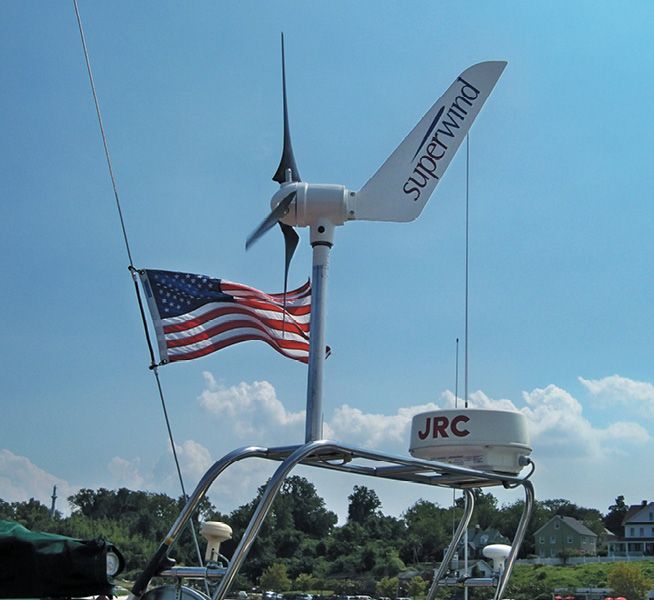
SOLAR PANELS
Solar panels have a lot going for them—they’re silent, have no moving parts and provide free electricity for years with minimal maintenance. They’re also modular, allowing you start small, and add more as your power requirements increase.
Solar power system inspections are relatively straightforward. Check the panels for physical damage, while ensuring they are securely mounted. When estimating typical output, use readings taken near noon with the panel mounted in a horizontal position. For a more precise evaluation of output, aim the panel for maximum solar exposure (see “Solar Power and Battery Checkup,” PS June 2023).
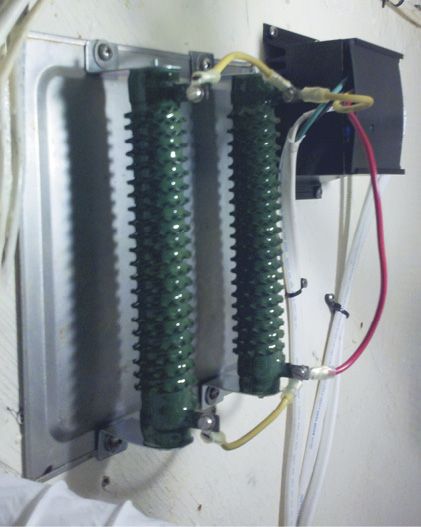
Articulating panels allow you to aim the panels towards the sun (thus generating more power), but with the caveat that you have to re-aim them periodically throughout the day to maximize output.
Inspect wire runs for issues such as chafe, lack of support or improper connections. Ensure all deck penetrations in the wire run are properly sealed and watertight to prevent water migration into panels with coring. Check that all connections are tight and corrosion free. You’ll also want to verify that the system is properly protected with appropriate fuses or breakers. Download the manufacturer’s installation instruction guide if it’s available.
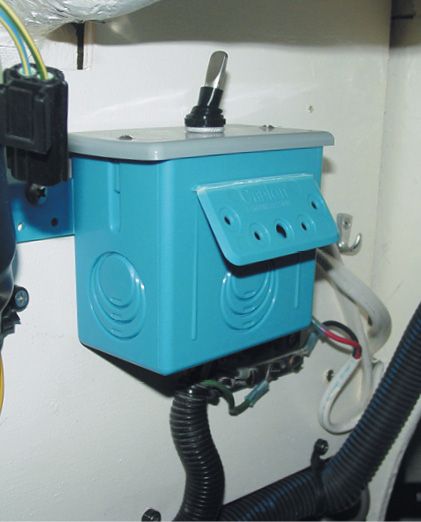
One of the more common issues I find with solar panel installations is lack of a charge controller or regulator, an important part of any solar panel installation and essential to preventing your batteries from overcharging. The charge controller should be mounted below decks and as close to the battery as possible.
Some sellers might tell you that they don’t need a charge controller because the battery bank is so large that it can’t be overcharged using the solar panel output. While that may be partly true, omitting a charge control is a terrible idea. It might save a few bucks initially, but your panel won’t deliver its full potential. In a worst-case scenario, you could end up harming the battery bank.
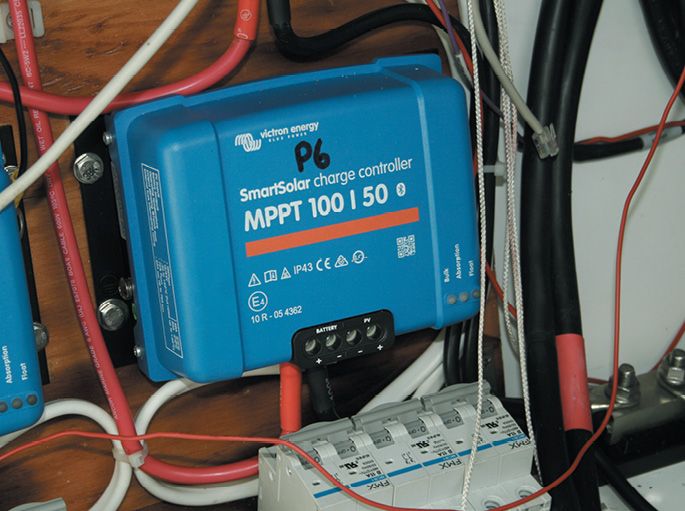
WIND TURBINES
Unlike solar panels (which require sunlight to operate), wind turbines have the potential to generate electricity 24 hours a day, 365 days a year.
Start the inspection of your wind turbine by looking at safety first. The turbine should be in a location that’s easy to access. You’ll need access for routine maintenance, and to secure or remove the blades for storm preparation. You also want it positioned high enough to prevent accidental contact with the captain and crew.
Verify that the turbine is securely mounted on a suitably strong structure, such as a stern pole or arch. Stern poles will consist of a stainless steel or aluminum tube about 2 inches in diameter. Stainless steel is stronger, but aluminum tubing is lighter and easier to work with. Also, aluminum’s relative flexibility helps to dampen vibrations. Regardless of material, a stern pole must be firmly mounted with rail clamps, guy wires and/or rigid metal struts to provide diagonal support to the mounting pole. Bracing is crucial for strength and to reduce pole movement, which in turn minimizes vibration and noise below decks.
As with solar panels, your wind turbine must also have some form of power regulation to prevent overcharging the batteries. Some turbines have a built-in regulator. Like a solar panel charge controller, the wind generator regulator prevents overcharging. It does this by throttling down power production once your battery bank is fully charged.
Higher output turbines will have a more sophisticated external charge controller and a diversion resistor, also called a “dump load.” This design doesn’t completely cut-off turbine output, but rather diverts excess power to one or more dump load resistors once the charge voltage cutoff set point is reached. The dump load dissipates the excess energy in the form of heat. If your system features a dump load resistor, verify that the resistor is installed with plenty of air space around it, and that nothing about the installation presents a fire risk. This resistor can get very hot.
The system should also have proper fuse or breaker protection. Ideally, it should also have a stop switch, which allows you to remotely shut down the wind generator in the event of a storm, or to prevent the rotor from turning during maintenance, repairs, or when working in the area where the turbine operates.
Finally, as with a solar panel inspection, you’ll also want to confirm that wire run deck penetrations are properly sealed and watertight. Inspect the installation and verify that connections are corrosion free, and that wire runs are properly supported and free from chafe or other issues.
HYBRID SYSTEMS
If your vessel has both solar panels and a wind turbine, a conflict between the solar panel and wind turbine charge controllers can get overlooked. In a nutshell, this problem occurs when the charge controller for your solar panel and the charge controller for your wind turbine are internally adjusted to the same maximum charge voltage set point. As a result, the two charge controllers are constantly fighting, turning each other on and off while jockeying for position as the dominant charging source. As a result, the battery won’t be fully charged.
Charge controller confliction is easily resolved by adjusting the cutoff voltage of the charge controllers for the solar panel and wind turbine so that one is the dominant charging source. This dominant charge system (typically the turbine) is set at the optimal battery charge voltage, while the cut off voltage for the other is set about .2 volts less.


































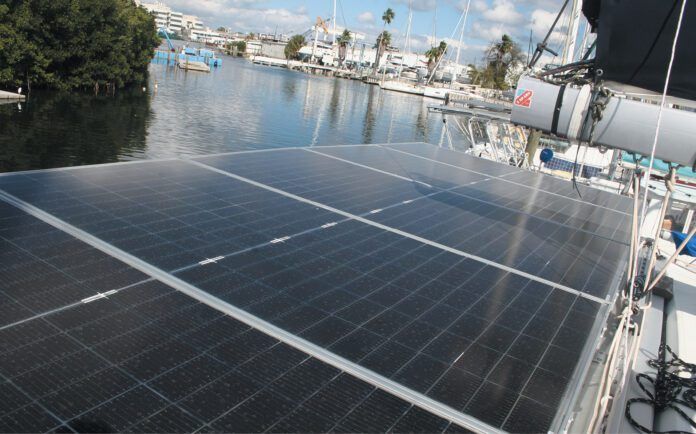





Sailors with solar systems should consider a seperate charge controller for each solar panel. Then configure the outputs of each charge controller in parallel at the battery. The primary reasons for individual charge controllers is that if a panel(s) fails or is sun blocked it does not take down the entire solar charging system.
Why would that happen, if the panels have the appropriate diodes? If a panel fails, either voltage or current would drop (depending on serial vs parallel configuration) but the whole system should not go down.
Of course separate controllers may have other benefits…